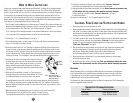
98
HOW TO MAKE CAPPUCCINO
Cappuccino is espresso topped with steamed and frothed milk. Frothing milk for cappuccino takes
practice. Do not be discouraged if it is not perfect the first time. The milk should be half steamed
(bottom of pitcher) and half froth (top of pitcher). It may take a few times before you perfect this process.
For best results, we recommend frothing the milk in a separate pitcher and pouring the milk into
your coffee. The milk and pitcher should be cold. Do not use a pitcher which has just been washed
in warm water. We also recommend a stainless steel frothing pitcher and a beverage thermometer,
if you own one, for preparing the best froth and steamed milk.
1.The first step in making cappuccino is to make espresso. Therefore, fill the glass carafe with cold
water to the designated marking for the desired number of servings. Never use warm or hot water
to fill the water reservoir. (See Chart from “How to Brew Espresso” on Page 6)
• For 2 servings, fill the decanter with water to the midpoint between the 2 and 4 cup markings.
• For 4 servings, fill the decanter with water up to the top of the metal band.
2. Follow steps 1 – 3 in “Brewing Espresso” on Page 6.
3.Fill a small stainless steel or ceramic pitcher 1/3 full with cold milk and set next to machine.
Skim or 2% milk will be the easiest to froth.
4.Rotate the control knob to the “cup” marking. The espresso will begin to flow in about three
minutes. As soon as the espresso reaches the steaming symbol on the glass carafe, turn the
control knob to the OFF position. At this time the unit has created enough pressure and steam
to start frothing the milk. Frothing the milk before finishing the espresso prevents you from
running out of steam. This can happen if you froth towards the end of the brewing process.
5.Hold the pitcher under the frothing tube so that the frothing aid
is slightly immersed in the milk. Turn the control knob slowly
to the “steam” position. Gently move the pitcher in a circular
motion around the steam nozzle. Because warm milk does
not froth, the milk should be frothed from just below the surface.
(See Figure 4)
6.When the milk has doubled in volume, or, if you are using a
beverage thermometer, when the milk has reached 100°F insert
the frothing aid deeper into the milk to further heat the milk.
To avoid splattering of hot milk, do not let the frothing aid go above the surface of the milk.
After frothing is completed, turn the control knob back to the “OFF” position. Set the pitcher
aside and allow the frothed milk to settle. Turn the control knob to the “cup” position to finish
making espresso.
7.When the espresso has stopped flowing into the carafe, turn the control knob to OFF.
Pour the espresso into a cup which has the capacity of at least 5 ounces.
Then add the steamed milk to the espresso and spoon on the frothed milk.
8.Follow the instructions on Page 3 under section marked
“C
AUTION
: P
RESSURE
”
to flush out any residual milk from the frothing tube and frothing aid.
9.Unplug the power cord and allow the machine too cool. Do not remove the reservoir cap
or filter holder until the pressure in the machine has been released.
Follow procedures in section marked
“C
AUTION
: P
RESSURE
”
on Page 3
to relieve the pressure.
10.Continue to follow steps 7 – 8 in “Brewing Espresso” on Page 7.
CLEANING YOUR ESPRESSO/CAPPUCCINO MAKER
1. Unplug the power cord from the electrical outlet.
2. Remove frothing aid and wipe frothing tube and aid with a damp cloth. The frothing tube may
still be hot, do not touch it with your hands. If steam does not flow through the frothing tube,
the tube may be blocked with milk. Turn off and unplug the appliance. After the appliance has
cooled, clean the frothing tube with a needle.
3. The carafe, carafe lid, filter holder, filter basket, and drip tray can be washed with soapy water
or placed on the top rack only of your dishwasher.
C
AUTION
:
Do not immerse appliance
in water. Do not remove reservoir cap while appliance is under pressure. See Section
“C
AUTION
:P
RESSURE
”
on Page 3.
4. After the pressure has been released, remove reservoir cap. Discard the remaining water
through
the top opening of the water reservoir by turning the
applianc
e upside down
over the sink. Always empty the water reservoir of any water between uses.
Do not immerse
applianc
e in water. Screw the
reservoir cap
back in place.
5. Wipe housing with a soft wet cloth. Do not use abrasive cleaners or scouring pads
as they will scratch the finish.
6. Do not store the filter holder in the brew head.
This can adversely affect the seal
between the brew head and the filter holder while brewing espresso
.
DELIMING
Mineral deposits built-up in the Espresso Maker will affect the operation of the appliance.
Your Espresso Maker must be delimed when you begin to notice an increase in the time
to brew espresso, or when there is excessive steaming. Also, you may notice a build up
of white deposits on the surface of the brew head.
The frequency of cleaning depends upon the hardness of the water used. The following table
gives the suggested cleaning intervals.
F
IGURE 4
N
OTE: FROTHING PITCHER
NOT INCLUDED UNLESS
O
THERWISE NOTED
S
UGGESTED
C
LEANING
I
NTERVAL
Type of Water Cleaning Frequency
Soft Water Every 80 Brew Cycles
Hard Water Every 40 Brew Cycles


















